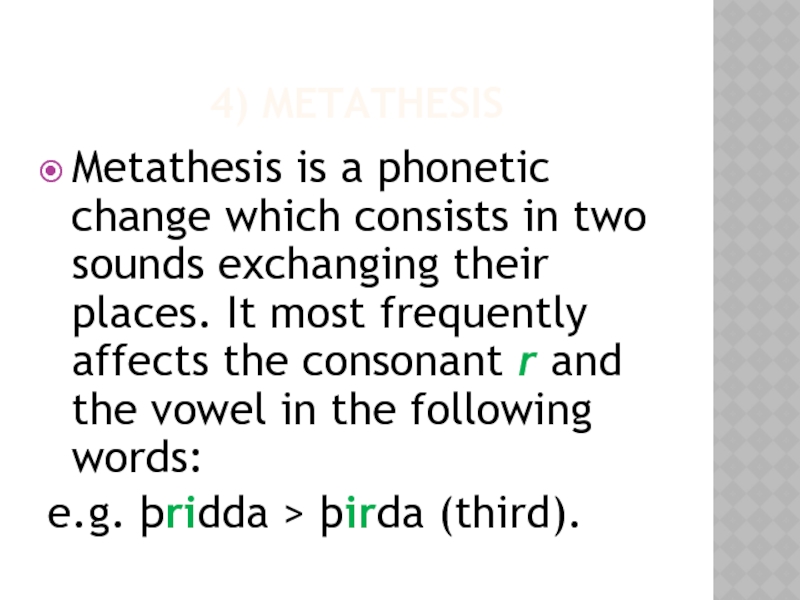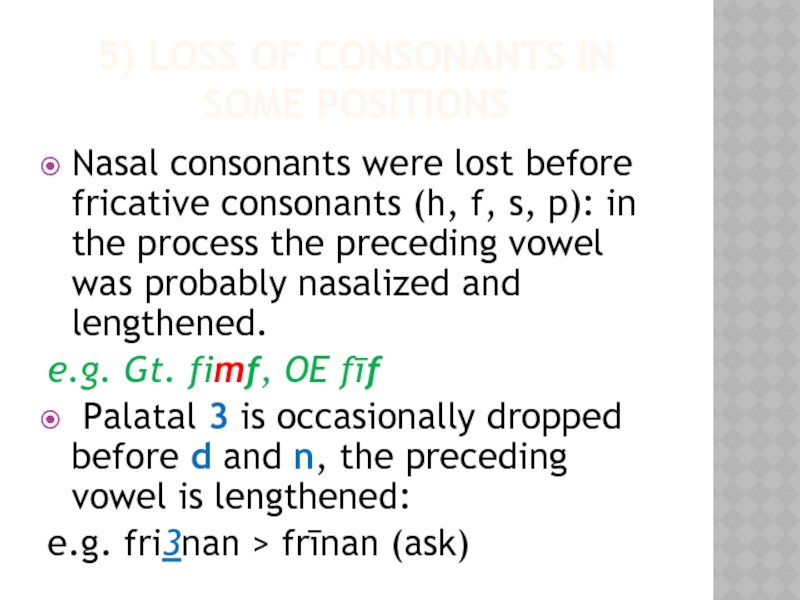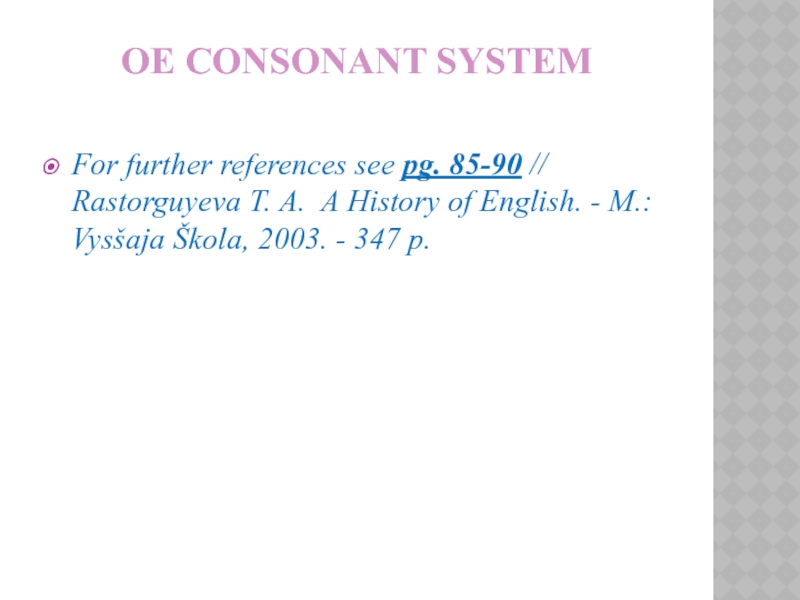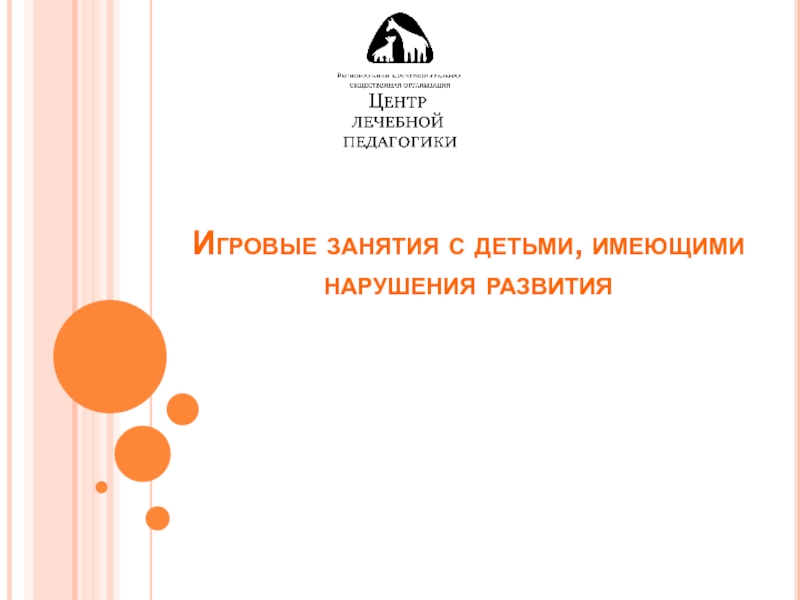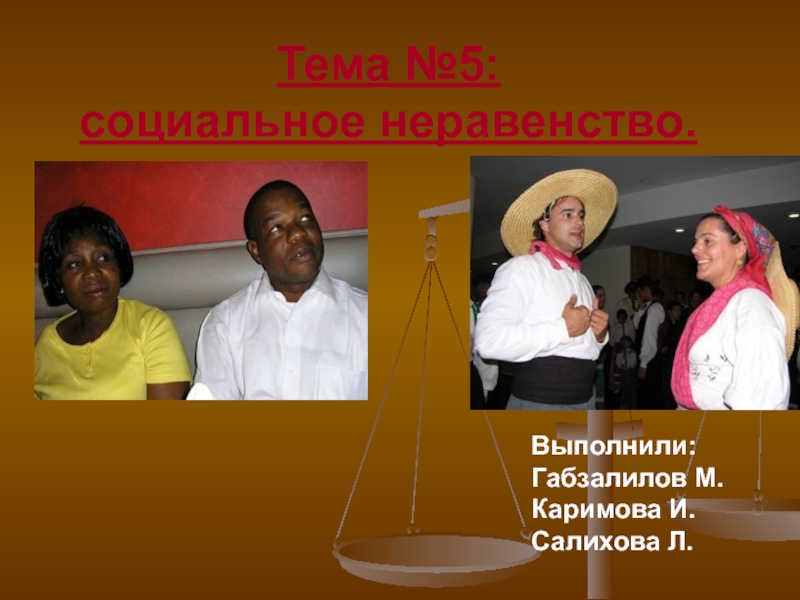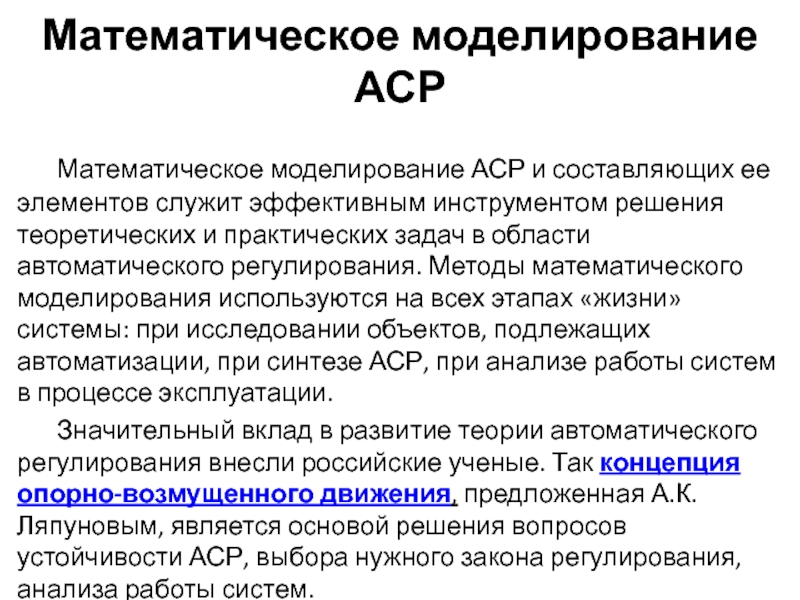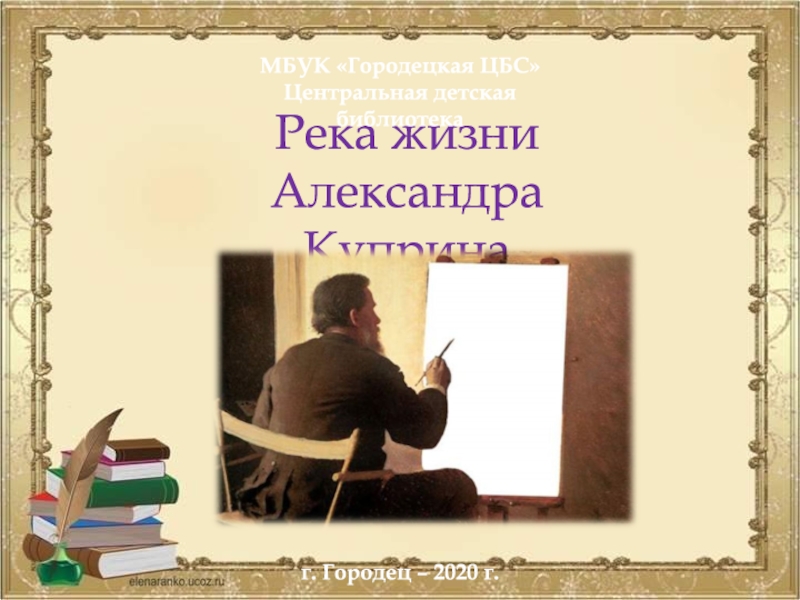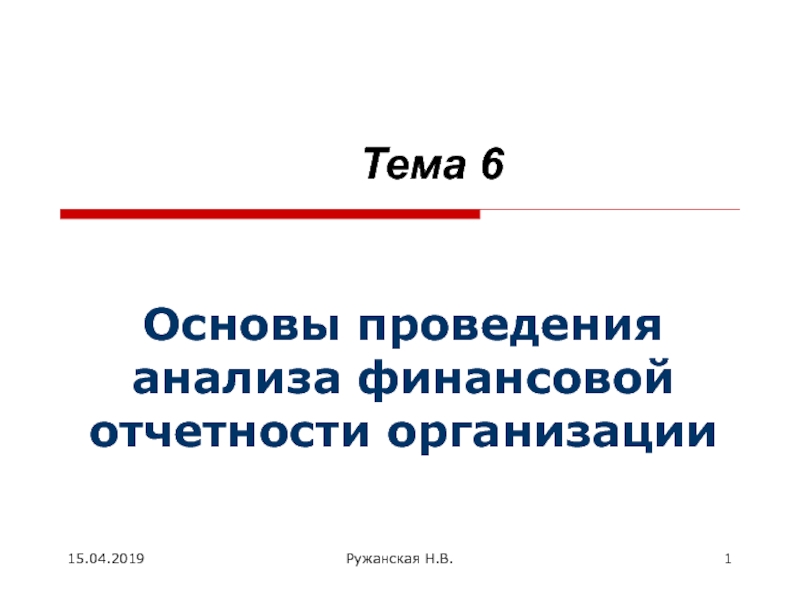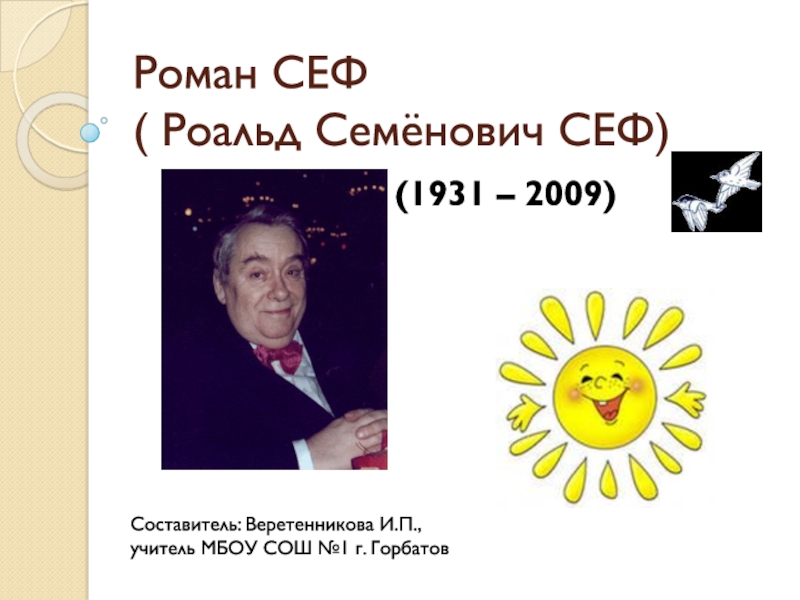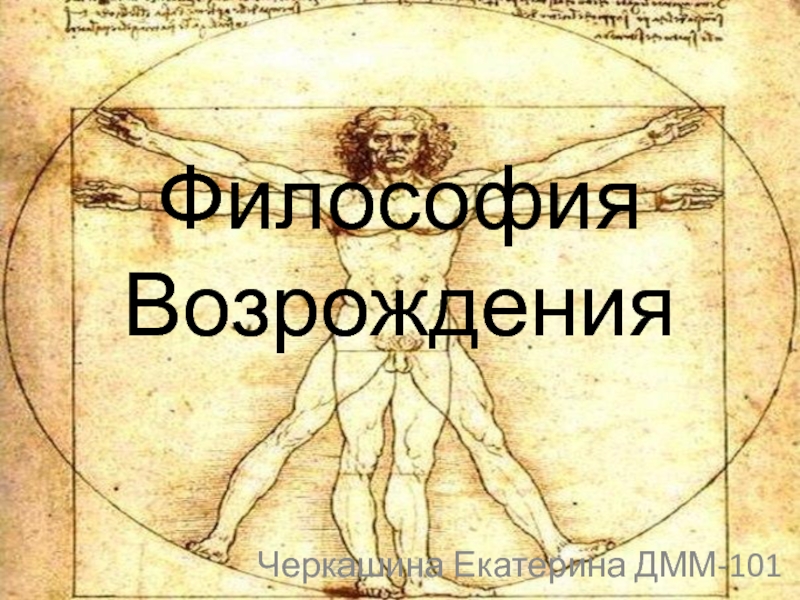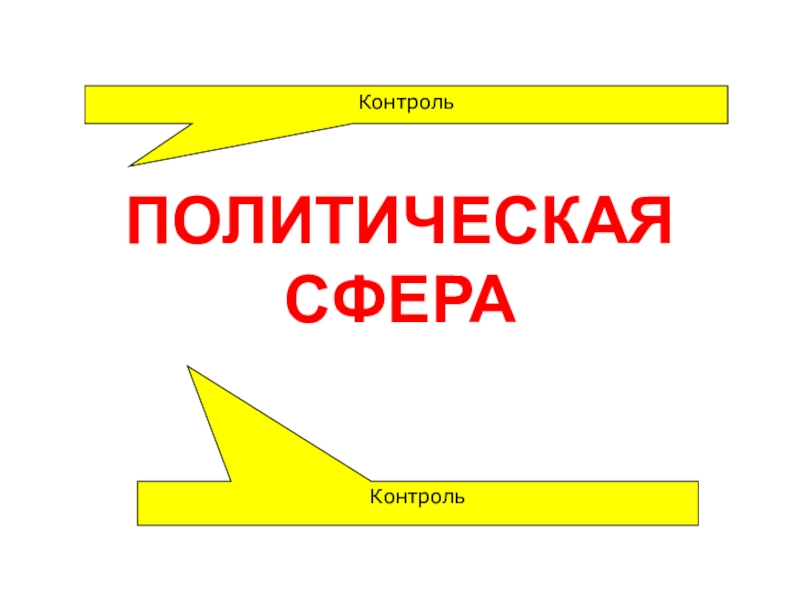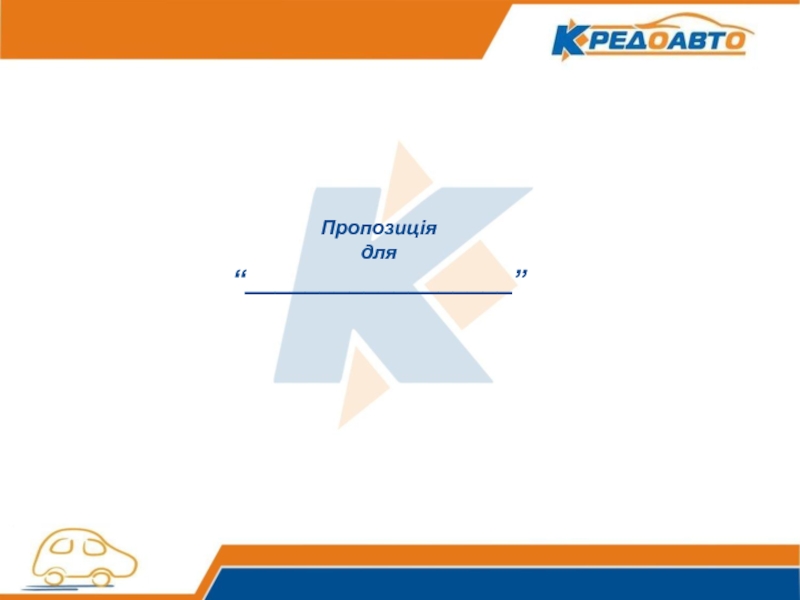Разделы презентаций
- Разное
- Английский язык
- Астрономия
- Алгебра
- Биология
- География
- Геометрия
- Детские презентации
- Информатика
- История
- Литература
- Математика
- Медицина
- Менеджмент
- Музыка
- МХК
- Немецкий язык
- ОБЖ
- Обществознание
- Окружающий мир
- Педагогика
- Русский язык
- Технология
- Физика
- Философия
- Химия
- Шаблоны, картинки для презентаций
- Экология
- Экономика
- Юриспруденция
Sound changes in Old English
Содержание
- 1. Sound changes in Old English
- 2. An OutlineI. Mechanisms of linguistic changeII. OE VocalismIII. OE consonant system
- 3. II. OE Vocalism 1) Qualitative changes:PG
- 4. III. OE consonant system1) West Germanic germination
- 5. All living languages undergo changes. What causes such changes?
- 6. I. Mechanisms of linguistic changegeographic or climaticbiological
- 7. Alterations:Qualitative // quantitative;Dependent // independent
- 8. II. Old English voCALISM 1) Qualitative changesPG
- 9. Anglo-Frisian Brightening (or First Fronting) The Anglo-Frisian
- 10. Restoration of a or RetractionLater in Old
- 11. Restoration of a or RetractionNominative
- 12. OE Breaking or fracture it is diphthongization
- 13. OE Breaking or fracture Gth. kalds –
- 14. It is mostly carried out in the
- 15. Palatalisation / Palatal diphthongization OE vowels also
- 16. Front mutation or i-umlaut It was
- 17. Слайд 17
- 18. Front mutation made considerable changes in the
- 19. i-umlaut led to the appearance
- 20. Velar umlaut It was the diphthongization
- 21. Velar umlaut i > io
- 22. Quantitative changes ContractionLengthening
- 23. Contraction e/æ + h+ vowel
- 24. Lengthening Vowels were lengthened before the
- 25. In classical Old English there were seven long vowels and seven corresponding short vowels.
- 26. I(:)
- 27. OE Consonant system Perhaps the most
- 28. In all WG languages at an early
- 29. The change didn’t affect the sonorant [r],
- 30. Palatalisation and assibilationThe process by which the
- 31. In a similar way, the cluster sc,
- 32. 3) Voicing and devoicing of fricatives In
- 33. e.g. OE cweðan [ð] between vowels and
- 34. 4) MetathesisMetathesis is a phonetic change which
- 35. 5) Loss of consonants in some positionsNasal
- 36. OE Consonant System For further references see
- 37. Скачать презентанцию
An OutlineI. Mechanisms of linguistic changeII. OE VocalismIII. OE consonant system
Слайды и текст этой презентации
Слайд 3
II. OE Vocalism
1) Qualitative changes:
PG correspondences;
Anglo-Frisian Brightening and
Restoration of a;
OE Breaking;
Palatalisation;
I-umlaut;
U-umlaut, velar umlaut
2) Quantitative changes:
Contraction
Lengthening
Слайд 4
III. OE consonant system
1) West Germanic germination of consonants
2) Palatalisation
and assibilation
3) Voicing and devoicing of fricatives
4) Metathesis
5) Loss of
consonants in some positionsСлайд 6I. Mechanisms of linguistic change
geographic or climatic
biological or racial
fashion
minimization
of effort
the influence of other languages
human inventions
changes in
social culture and moral values Слайд 8II. Old English voCALISM
1) Qualitative changes
PG correspondences
Gth. ai – OE
a:
e.g. Gth. stains – OE stān (stone)
Gth. ei –
OE i: e.g. Gth. meins – OE mīn (mine)
Gth. au– OE ea:
Gth. eu – OE eo:
Gth. iu – OE io:
for greater understanding go to the chart on p. 12 [Иванова И.П., Чахоян Л.П., Беляева Т.М. Практикум по истории английского языка. – Cпб., 2005]
Слайд 9Anglo-Frisian Brightening (or First Fronting)
The Anglo-Frisian languages underwent a
sound change in their development from Proto-Germanic by which the
vowel ā was fronted to ǣ, unless followed by a nasal consonant (n, m).Cf. OE mann and OE dæġ
Слайд 10Restoration of a or Retraction
Later in Old English, short /æ/
(and in some dialects long /æː/ as well), was backed
to /ɑ/ when there was a back vowel (a, o, u)in the following syllable.
Cf. Dæġ and dagas
Слайд 11Restoration of a or Retraction
Nominative dæġ
dagas
Accusative dæġ
dæġGenitive dæġes daga
Dative dæġe dagum
For further references see pg. 76 // Rastorguyeva T. A. A History of English. - M.: Vysšaja Škola, 2003. - 347 p.)
Слайд 12OE Breaking or fracture
it is diphthongization of short vowels
before certain consonant clusters (before r, l, h + consonant
and before h final).It is vowels a and e that underwent fracture.
Слайд 13OE Breaking or fracture
Gth. kalds – WS ceald
For further references see pg. 78-80 // Rastorguyeva T. A.
A History of English. - M.: Vysšaja Škola, 2003. - 347 p.Слайд 14It is mostly carried out in the West Saxon and
Kentish dialects and
the Anglian dialects have unbroken vowels
Cf.
WS and Kentish ceald “cold” and the Anglian dialects caldBreaking produced a new set of vowels in OE = the short [ea] and [eo].
Слайд 15Palatalisation / Palatal diphthongization
OE vowels also change under the
influence of the initial palatal consonants ʒ [j], c [k’]
and cluster sc [sc’].As a result of palatalization the vowel [e] and [æ] are diphthongized. E.g.:
OE scÆmu > OE sceamu ‘shame’
For further references see pg. 78-80 // Rastorguyeva T. A. A History of English. - M.: Vysšaja Škola, 2003. - 347 p.)
Слайд 16Front mutation or i-umlaut
It was a series of
changes to vowels which took place when there was an
i, ī or j in the following syllable.Subsequently, the i, ī or j disappeared, or changed to e.
Слайд 18Front mutation made considerable changes in the pronunciation of English.
Examples of i-umlaut in Mod English: food and feed, goose
and geese, tooth and teeth, blood and bleed, man and men.Слайд 19
i-umlaut led to the appearance of new vowels:
[y]
and [y:] arose from palatal mutation;
Diphthongs [ie] and [ie:]
For further
references see pg. 80-82 // Rastorguyeva T. A. A History of English. - M.: Vysšaja Škola, 2003. - 347 p.)Слайд 20Velar umlaut
It was the diphthongization caused by
an unstressed back vowel (u, o, a) in the following
syllable, when only a single consonant intervened.Слайд 21Velar umlaut
i > io hira > hiora
(their)
e > eo hefon > heofon
a > ea
saru > searu (armour)For further references see pg. 82 // Rastorguyeva T. A. A History of English. - M.: Vysšaja Škola, 2003. - 347 p.
Слайд 24Lengthening
Vowels were lengthened before the clusters nd, ld,
mb
Cf. bindan > bīndan
Cild > cīld but cildru = because
the cluster is followed by another consonantСлайд 27OE Consonant system
Perhaps the most obvious difference between
Old English and present-day English is the existence in the
former of geminate consonants.1) West Germanic germination of consonants
Слайд 28In all WG languages at an early stage of their
independent history, most consonants were lengthened after a short vowel
before [j]. This process is known as WG germination or doubling of consonants, the resulting long consonants are indicated by means of double letters:e.g. fuljan > OE fyllan.
Слайд 29
The change didn’t affect the sonorant [r],
e.g. OE werian;
nor did it operate if the consonant was preceded by
a long vowel e.g. OE dēmjan – OE dēman
Слайд 30Palatalisation and assibilation
The process by which the velar consonant is
fronted is called palatalisation
The velar consonants [k, g,
x, γ] were palatalized before a front vowel (e, I, y).e.g. OE cild [k] was softened to [k’] as it stood before the front vowel [i].
Слайд 31In a similar way, the cluster sc, as in scip
(ship), became palatalized;
By the 9th century, however, the new palatal
stops had developed into the palato-alveolar affricates. The affricate development is usually called assibilation.e.g. OE cild [k] was softened to [k’] at it stood before the front vowel [i]. in Late OE it may have reached the stage of [t∫]
Слайд 323) Voicing and devoicing of fricatives
In the meantime the
PG set of voiceless fricatives [f,θ, x, s] was subjected
to a new process of voicing and devoicing.In early OE they became or remained voiced intervocally (between vowels), sonorants and voiced consonants; they became or remained voiceless in other environments, namely, initially, finally and next to other voiceless consonants:
Слайд 33e.g. OE cweðan [ð] between vowels and OE cwæð [θ]
at the end of the word;
OE Nom, Acc case
– wīf, Gen – wīfes OE spelling does not distinguish between voiced and voiceless fricatives.
Слайд 344) Metathesis
Metathesis is a phonetic change which consists in two
sounds exchanging their places. It most frequently affects the consonant
r and the vowel in the following words:e.g. þridda > þirda (third).
Слайд 355) Loss of consonants in some positions
Nasal consonants were lost
before fricative consonants (h, f, s, p): in the process
the preceding vowel was probably nasalized and lengthened.e.g. Gt. fimf, OE fīf
Palatal 3 is occasionally dropped before d and n, the preceding vowel is lengthened:
e.g. fri3nan > frīnan (ask)
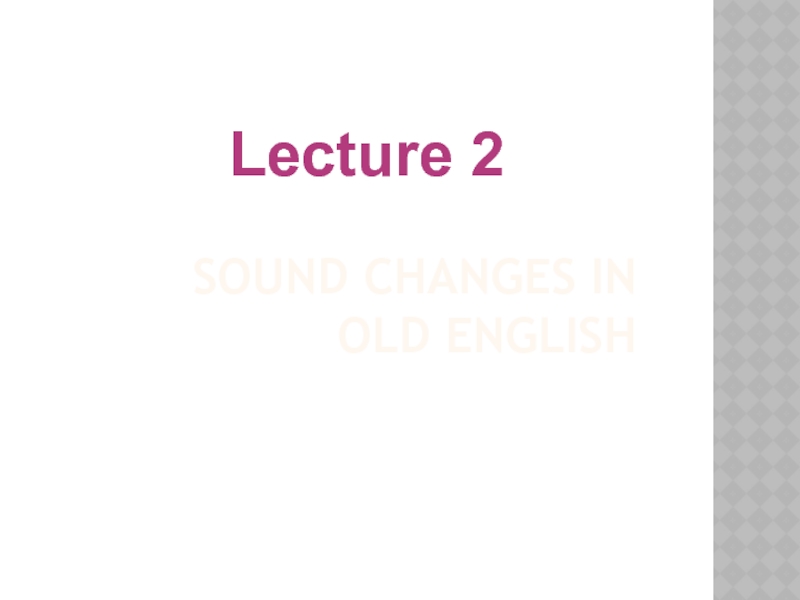
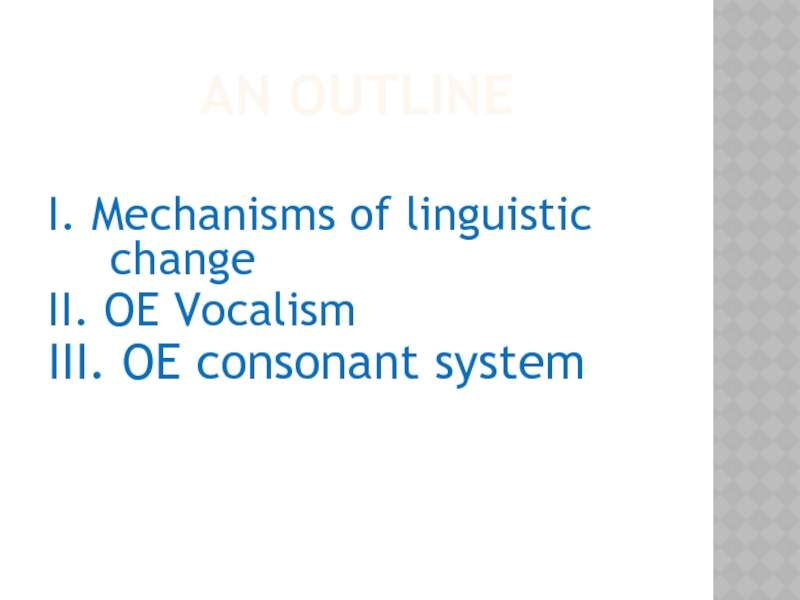
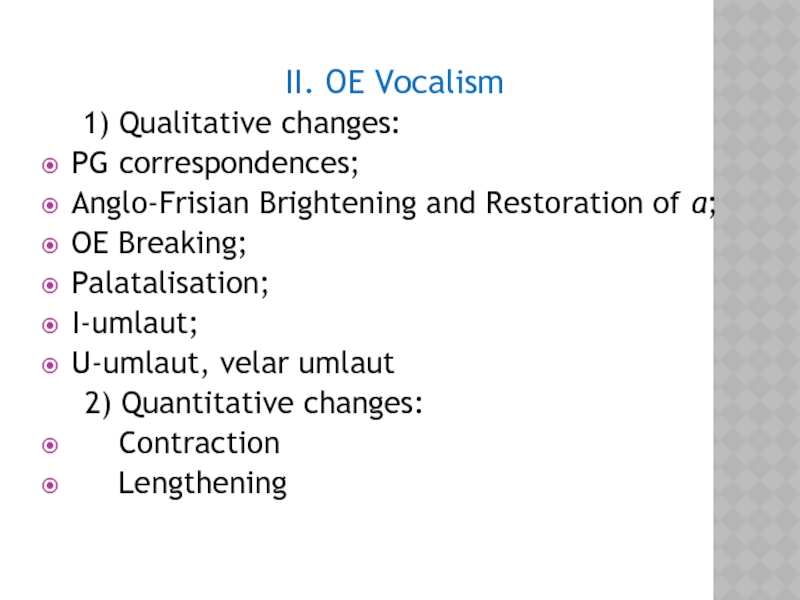
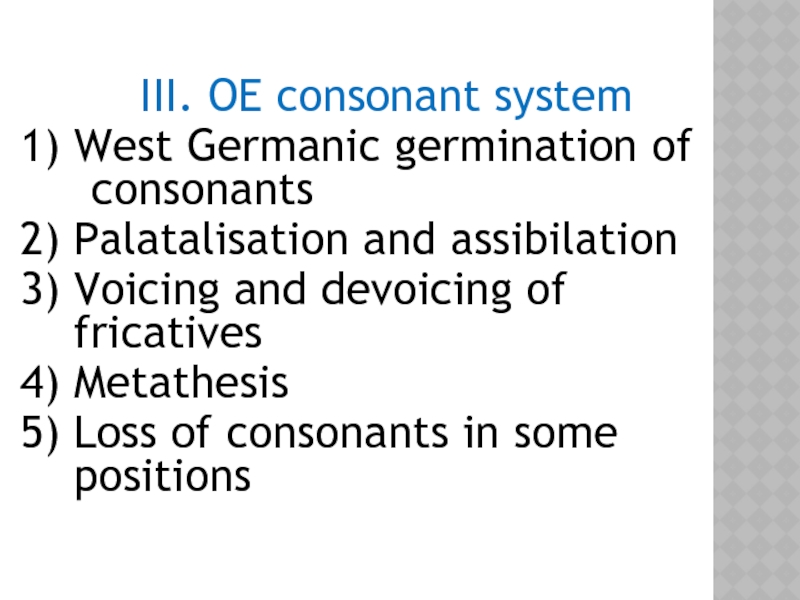
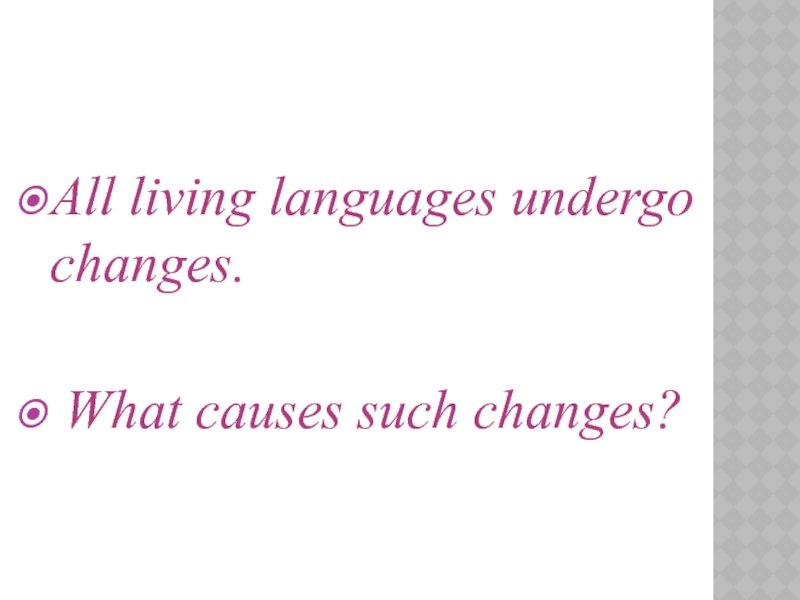
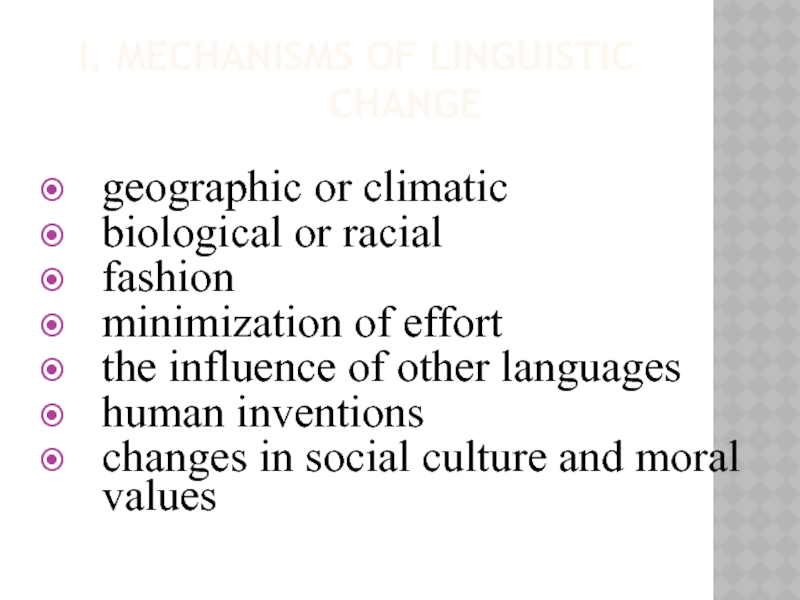
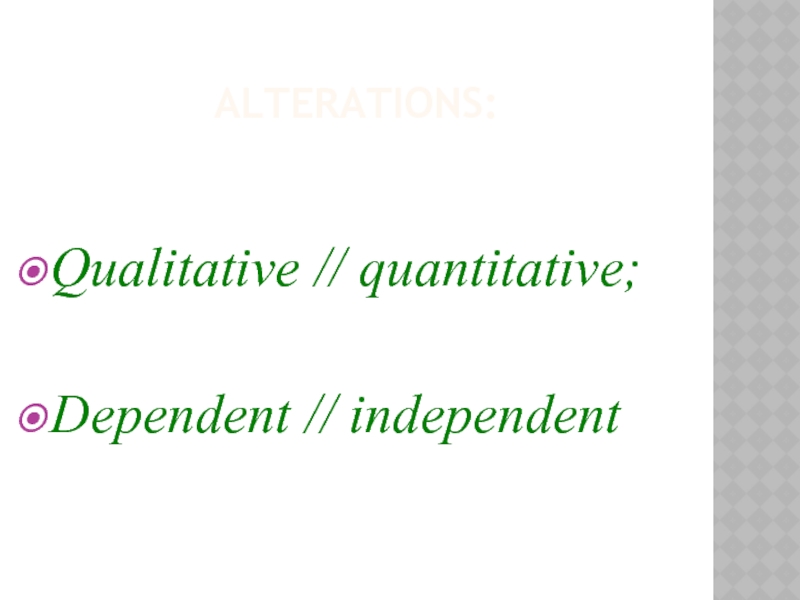
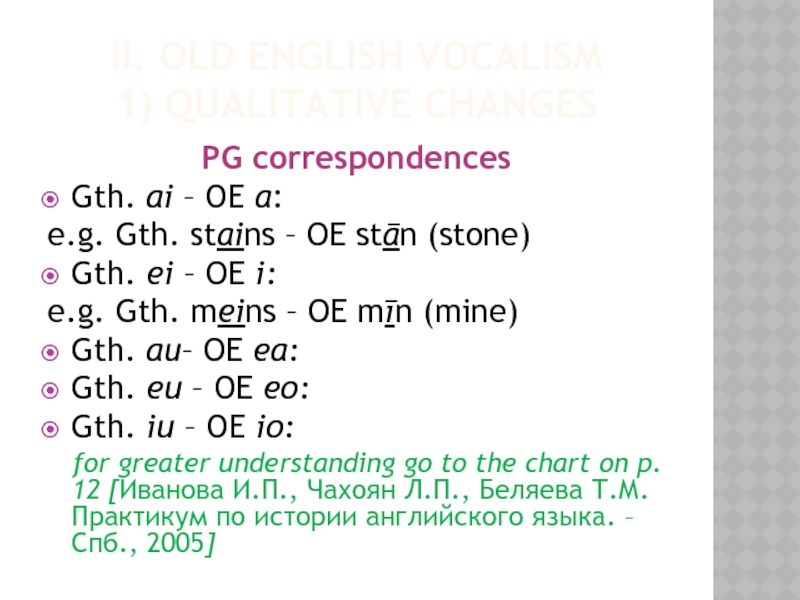
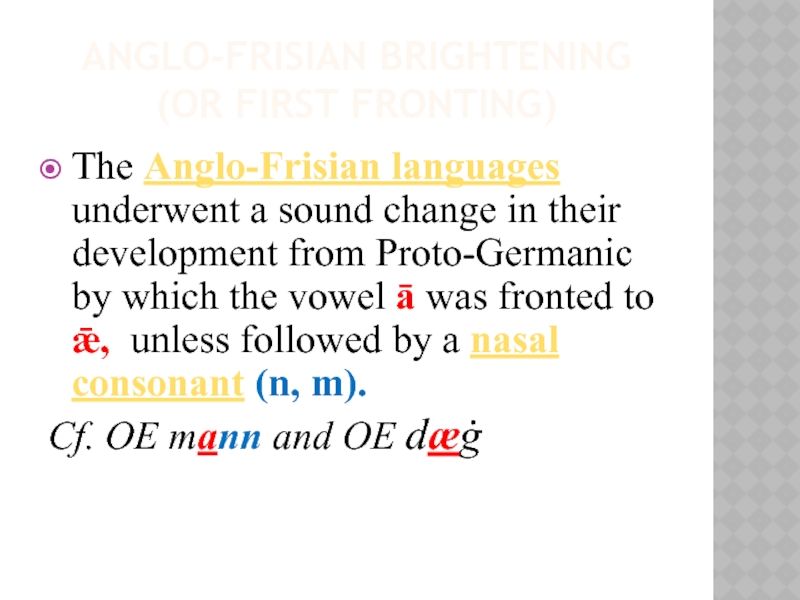
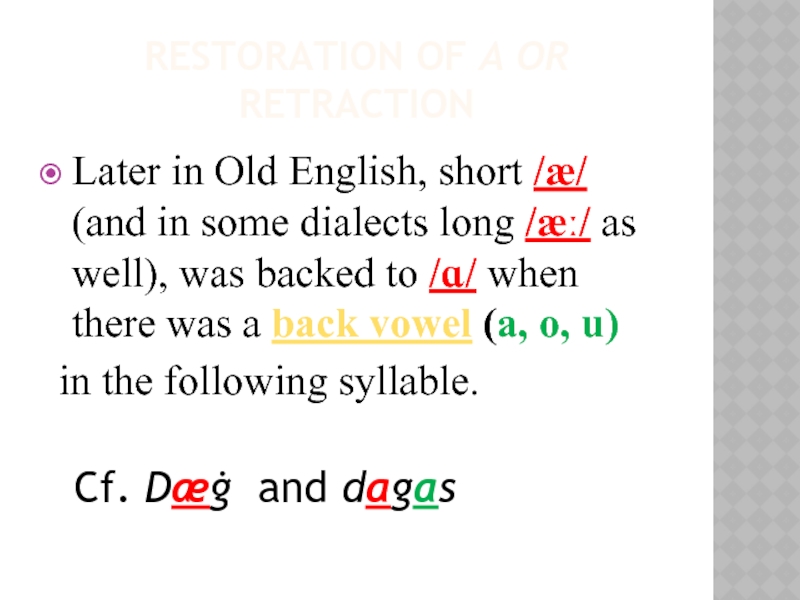
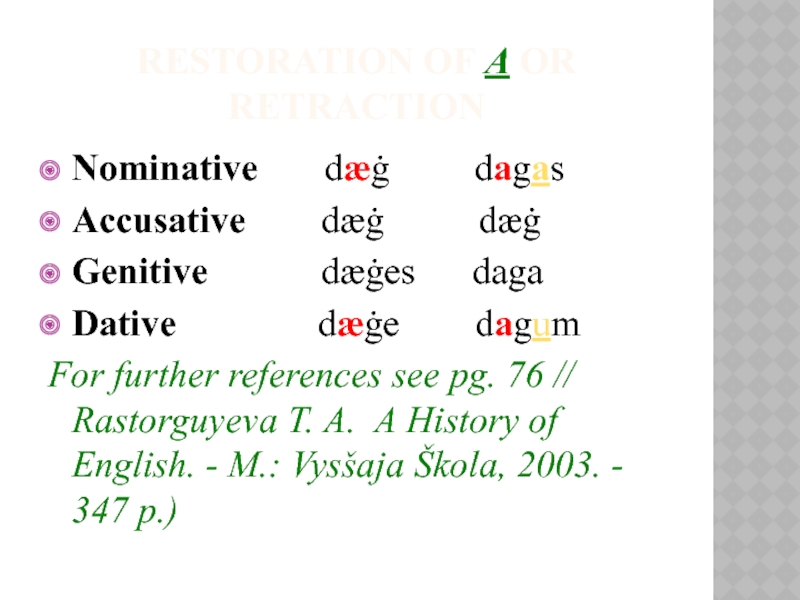
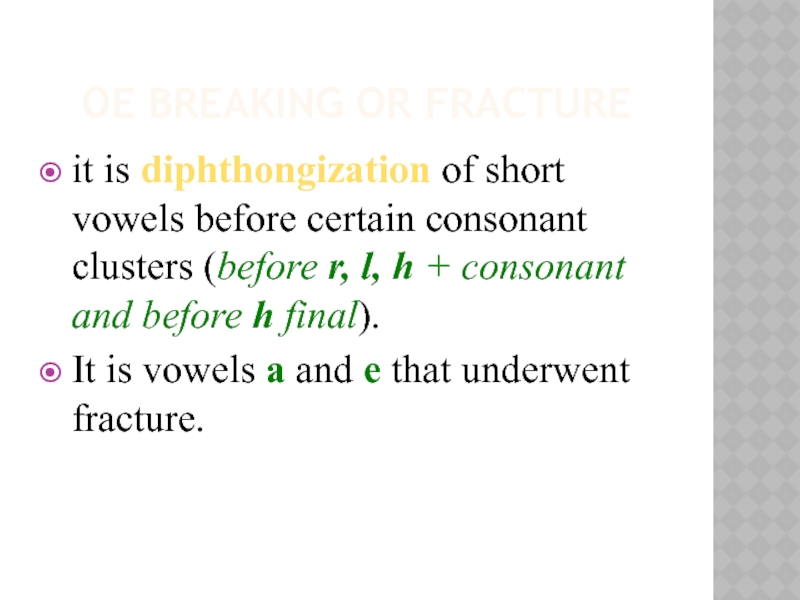
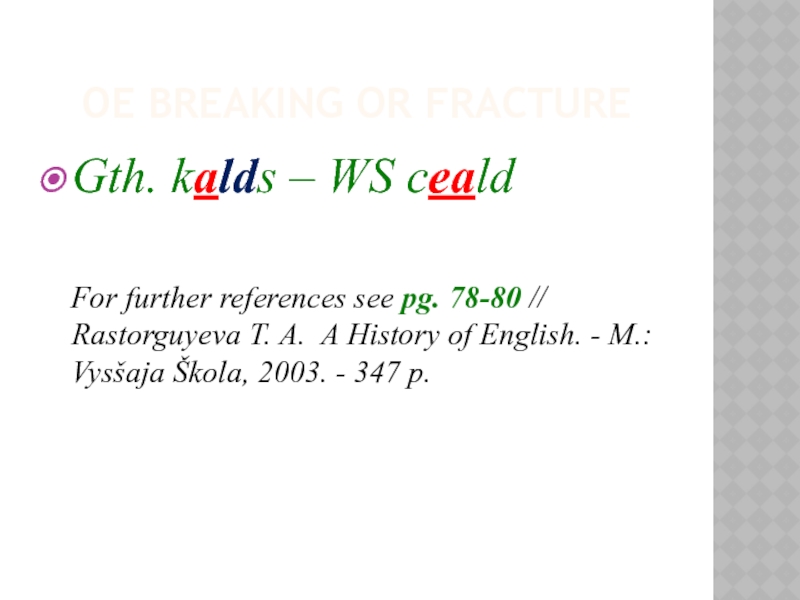
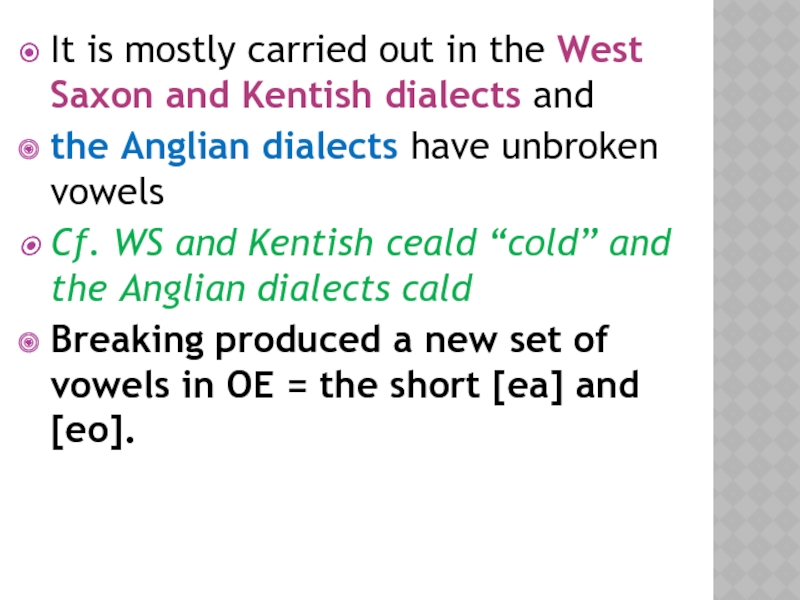
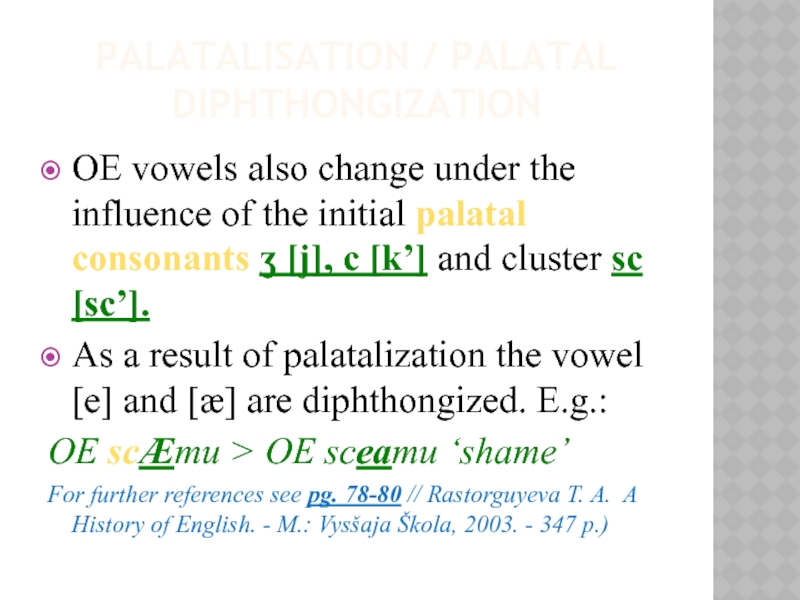
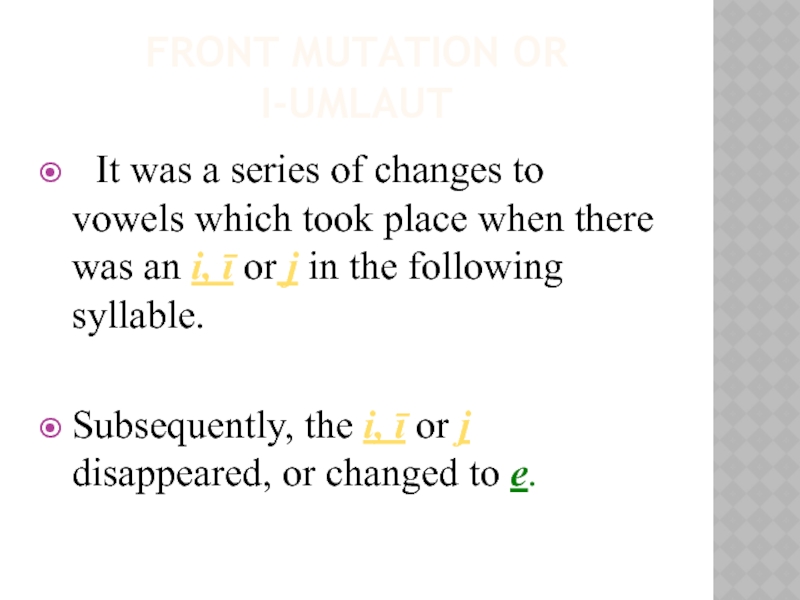
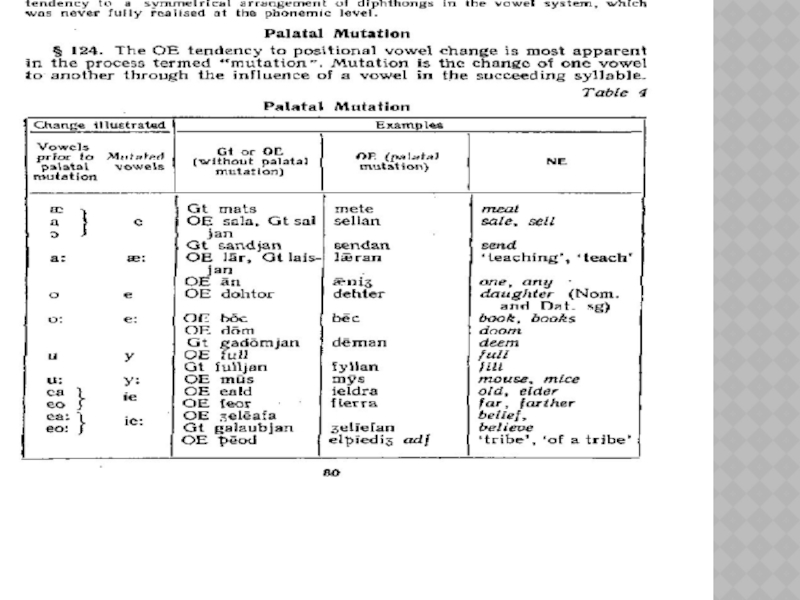
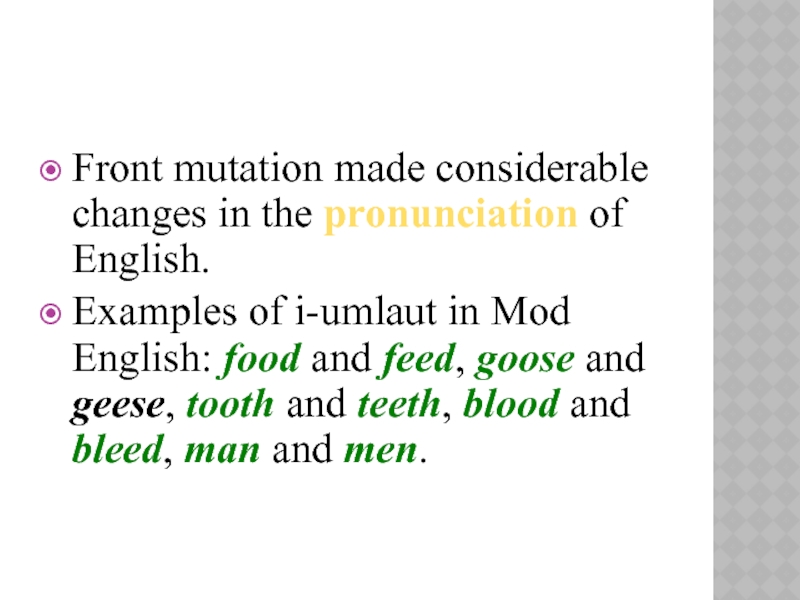
![Sound changes in Old English i-umlaut led to the appearance of new vowels:[y] and [y:] i-umlaut led to the appearance of new vowels:[y] and [y:] arose from palatal mutation;Diphthongs [ie]](/img/thumbs/c5ba1c1eb1b4ae84d5ae1ee3ce4a9b66-800x.jpg)
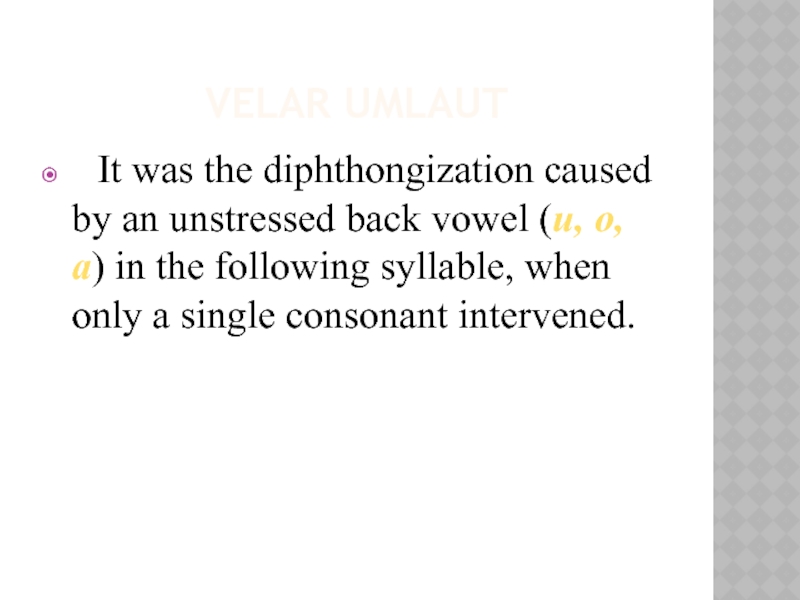
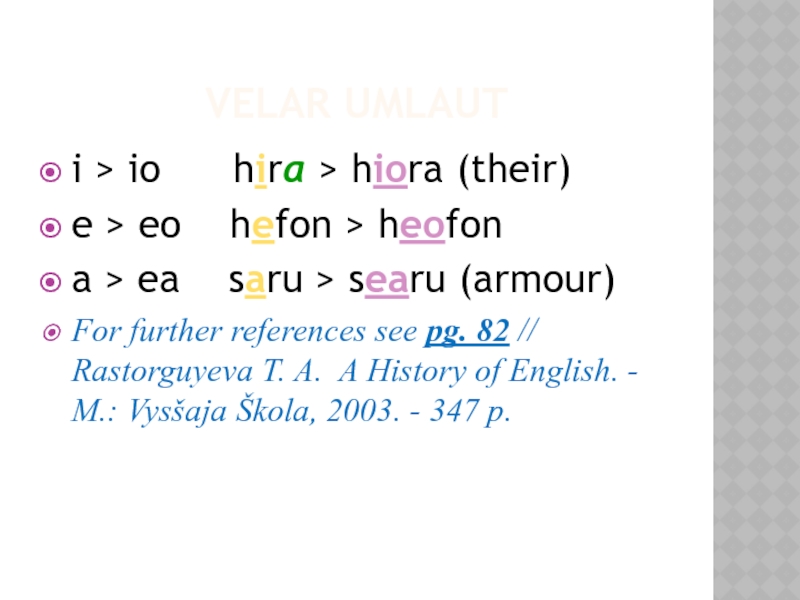

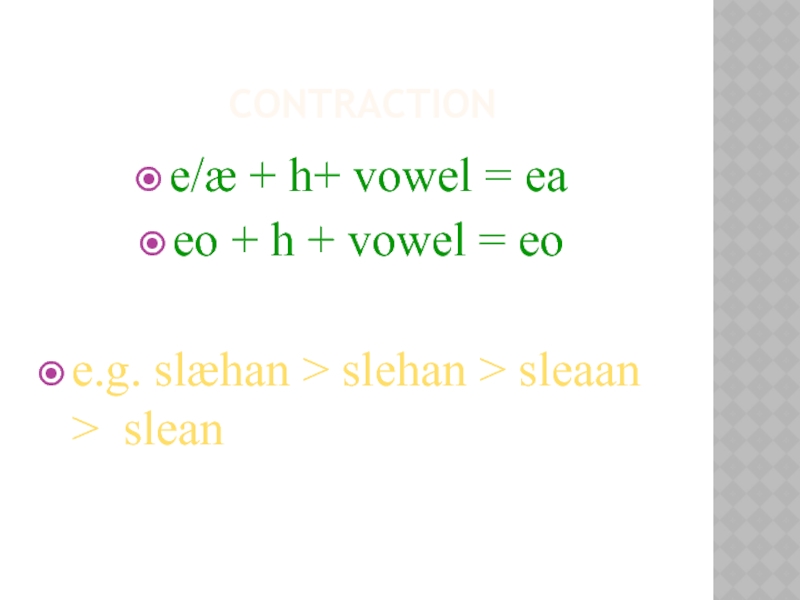
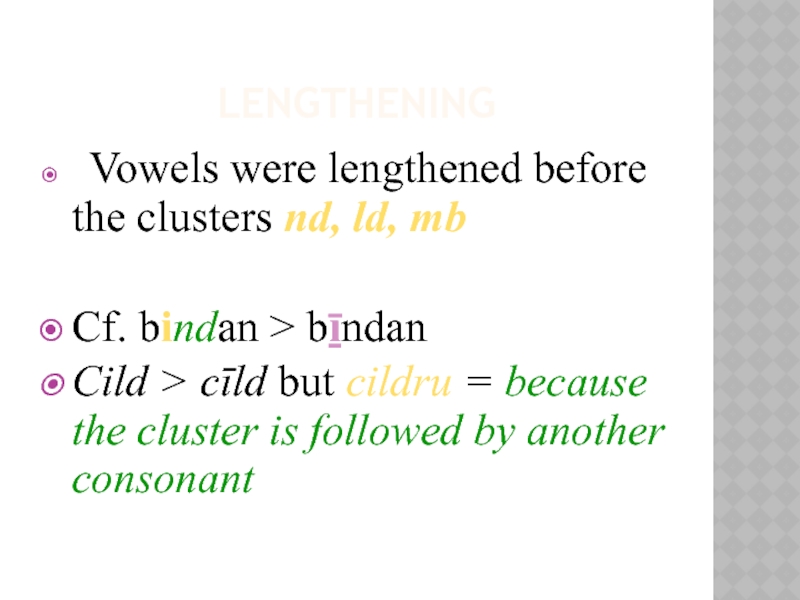
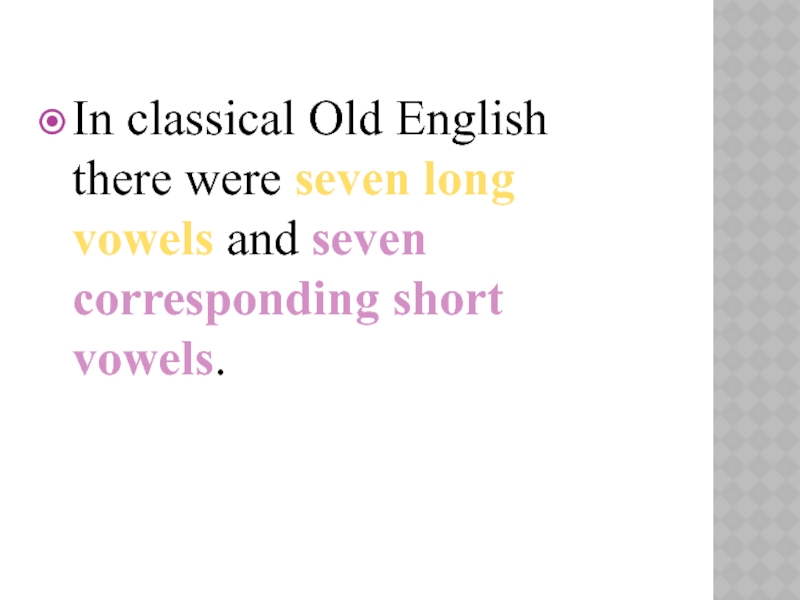
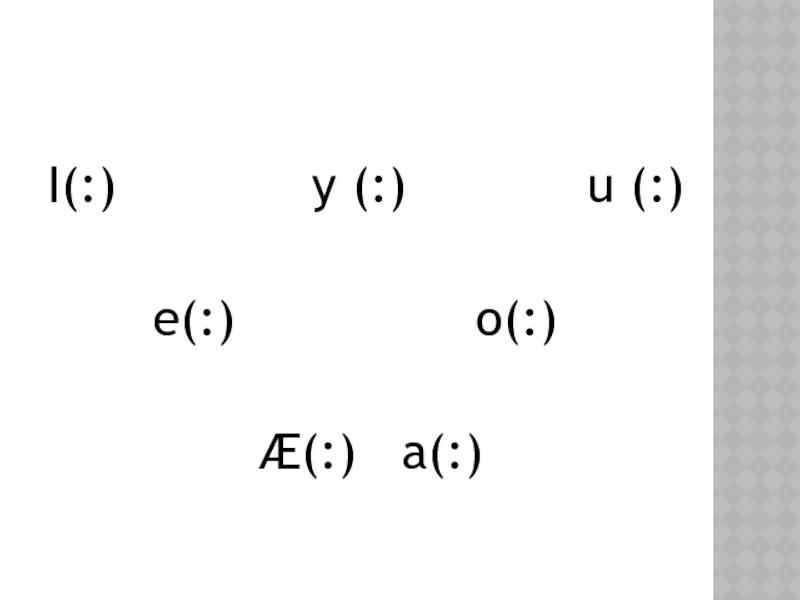
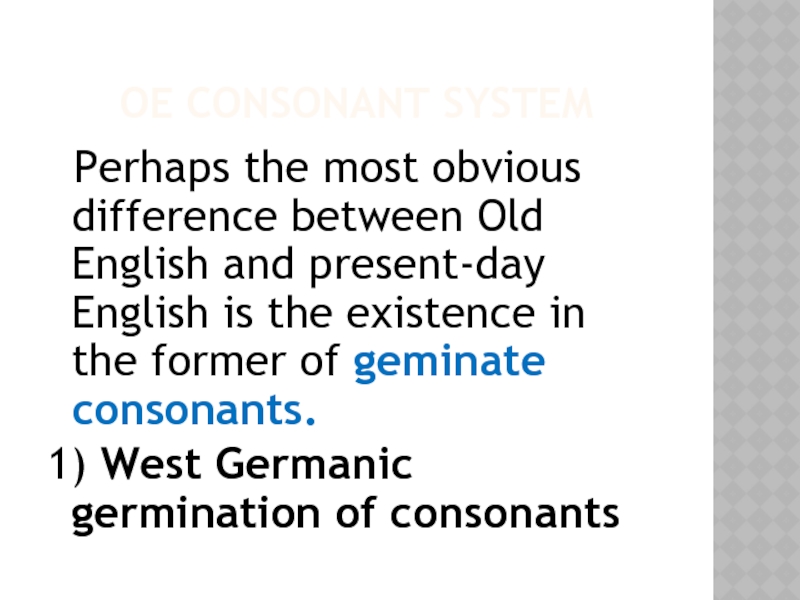
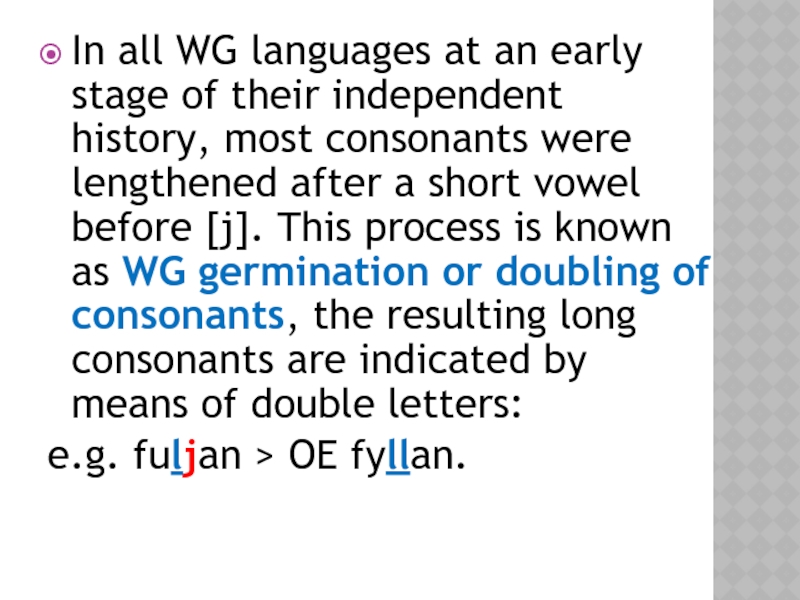
![Sound changes in Old English The change didn’t affect the sonorant [r], e.g. OE werian; nor The change didn’t affect the sonorant [r], e.g. OE werian; nor did it operate if the consonant](/img/thumbs/71d4603a62b454169a9c0e1f44f022f4-800x.jpg)
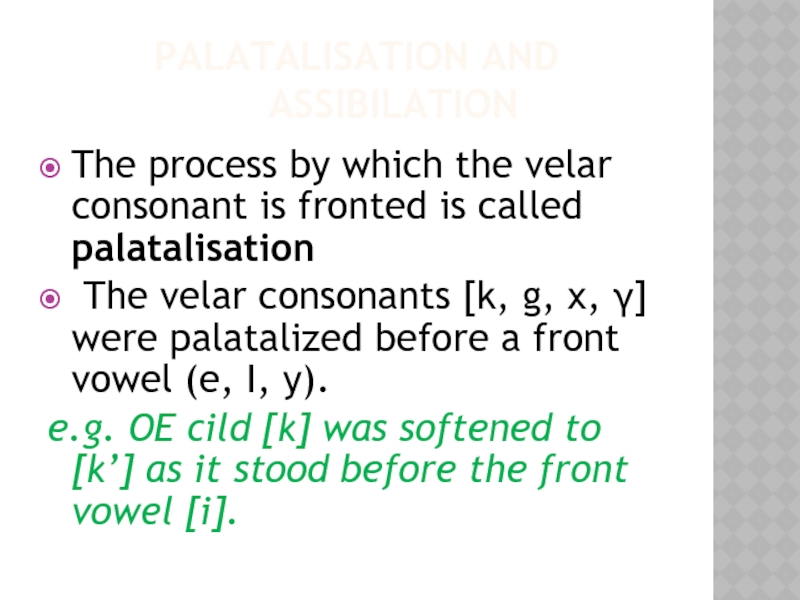
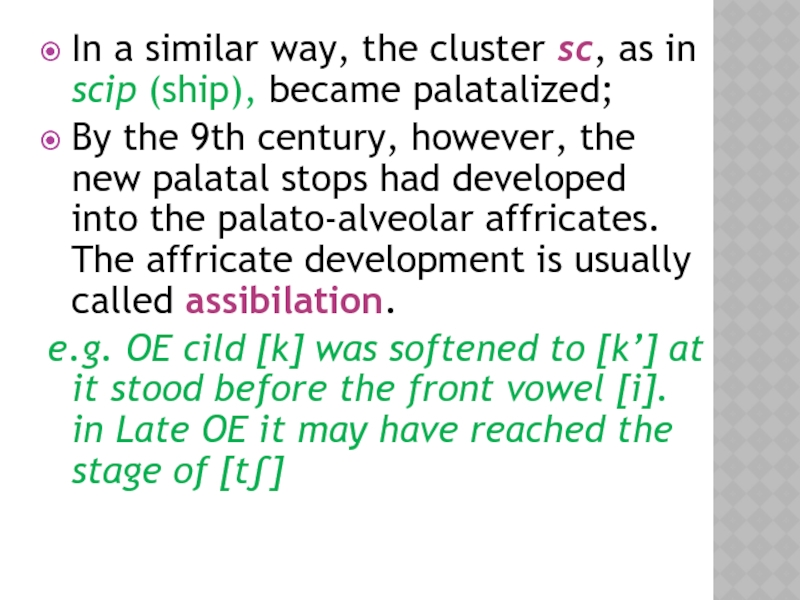
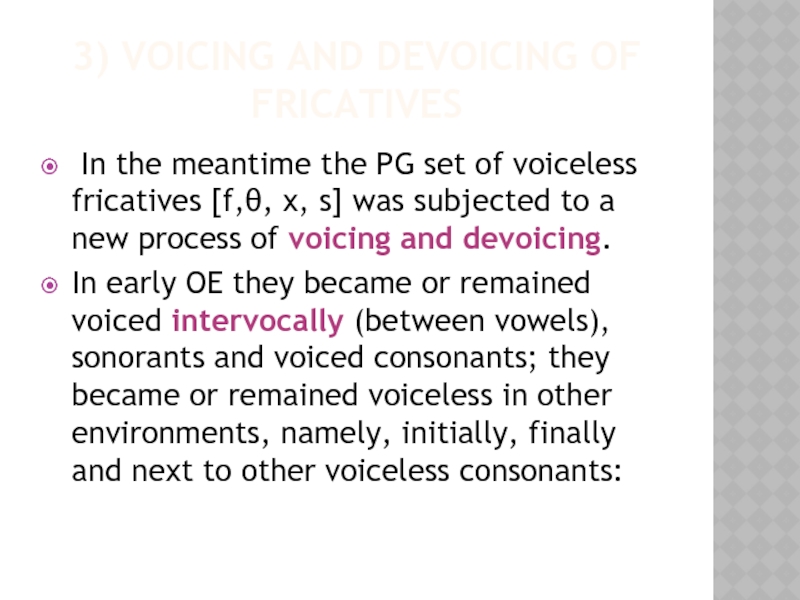
![Sound changes in Old English e.g. OE cweðan [ð] between vowels and OE cwæð [θ] at e.g. OE cweðan [ð] between vowels and OE cwæð [θ] at the end of the word; OE](/img/tmb/4/357017/3b19e81e6db1338f6ea56301cc2b71c7-800x.jpg)
